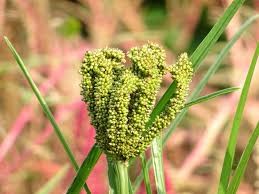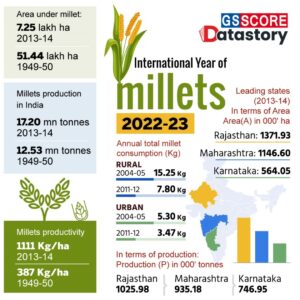Importance of Millets in India:
The Poaceae family includes the small-seeded annual grasses known as millets, which are typically grown as grain crops on marginal land in dry areas. The ancient grain known as millets was first domesticated for human consumption and is now grown in 131 nations. In Asia and Africa, millets are the staple diet for 59 crore people. Only millets will address pressing issues like food, feed, fuel, malnutrition, health, and climate change in the future. Millets fit well even in the infertile soil and are adapted to a wide range of ecological conditions requiring less water and inputs. India grows nine different varieties of millets. Sorghum, Pearl Millet, and Finger Millet make up the majority of millets grown in India, accounting for 95% of the country’s total millet growing area. The remaining 5% of millets include Little Millet, Foxtail Millet, Barnyard Millet, Proso Millet, Kodo Millet, and Browntop Millet.

Nutritional Importance of Millets:
Millets are a rich source of nutrients and are now referred to as Nutri-Cereals. When it comes to nutrients and health advantages, millets are exceptional. Millets are therefore miraculous. The most iron is found in pearl millet. It can treat anaemia in India and contains 4 to 8 mg per 100 g of grain. It is advised for expectant mothers because it is also high in zinc and folic acid. Milk’s protein content is double that of pearl millet’s. There is sufficient evidence to support millets’ potential to control and prevent diabetes, according to a recent systematic review and meta-analysis of millets. Millets’ low glycemic index aids in the control of diabetes. The highest calcium content is found in finger millet, also known as ragi, with 364 mg per 100 g of grains. It has three times the calcium of milk. The bones and teeth are kept strong by this calcium-rich grain.Dietary fiber-rich millets aid in digestion and ward off constipation. Kodo millet has a high level of dietary fibre that is 10 times more than rice and 3 times more than wheat and maize combined. Millets’ high fibre content functions as pre-biotics and aids in maintaining a balanced gut microbiome. Millets are excellent for celiac patients because they are completely gluten-free. Antioxidants found in millets help shield our cells from free radical damage. Millets can lower the risk of developing cardiovascular diseases, according to a recent study. Millets aid in weight reduction. Millets’ unique composition, which includes dietary fibre, polyols, and tryptophan, aids in weight loss.
Nutritive value of Ragi
Finger millet is regarded as one of the most nutrient-dense cereals. Finger millet has a protein content of 5-8%, an ether extractive content of 1-2%, a carbohydrate content of 65-75%, a dietary fibre content of 15-20%, and a mineral content of 2.5-3.5%. Finger millet has the most calcium (344mg%) and potassium (408mg%) of any cereal or millet. The cereal has a low-fat content (1.3%) and is mostly made up of unsaturated fat. 100 grammes of finger millet contain approximately 336 KCal of energy on average. However, millet contains phytates (0.48%), polyphenols, tannins (0.61%), trypsin inhibitory factors, and dietary fibre, which were previously classified as “anti-nutrients” due to their metal chelating and enzyme inhibition activities (Thompson 1993), but are now classified as nutraceuticals. Because it is non-glutinous, finger millet is suitable for people with gluten intolerance and celiac disease. It is non-acidic and thus easy to digest. Finger millet contains a lot of amino acids (Tryptophan, Threonine, Valine, Isoleucine and Methionoine).
Importance of Millets in the Indian Agriculture Sector:
Millets have advantages for your health in addition to being resistant to climate change because they can withstand a wide range of temperatures and moisture levels and require less maintenance to grow. They are resilient crops with small water and carbon footprints. It can withstand drought, and millets can even survive on 350–400 mm of rainfall. Millets grow more quickly, causing less environmental stress. As proposed by India to the Food and Agriculture Organization, the United Nations General Assembly adopted a resolution designating 2023 as the International Year of Millets. The main goal of this initiative is to raise public awareness of the health benefits of millets and their suitability for cultivation under challenging conditions brought on by climate change.

Importance of millets in the context of Climate Change:
It is anticipated that rising temperatures will result in lower rice yields. Therefore, in order to deal with shifting agricultural patterns, adaptive measures must be taken into consideration. Climate change causes a decrease in yield, which causes food insecurity, an increase in pest and disease outbreaks, soil degradation, a shift in crop timing, and desertification. Millets are a better alternative crop, and we can say that they will be the crop of the future.
Economic Importance of Millets:
India is the world’s top producer of millets and the fifth-largest exporter of millets worldwide. As the demand for millets rises quickly, its exports are increasing exponentially. Fuel and feed needs are being met by millets. It might be used to make biofuel. More business opportunities are being created for entrepreneurs as millets’ demand rises. The millet market was worth over USD 9 billion in 2018 and is expected to grow at a rate of over 4.5% CAGR from 2018 to 2025, reaching a value of over USD 12 billion.
Health benefits of finger millet (ragi)
- Finger millet is a superior source of natural calcium that supports the skeletal health of growing children and ageing individuals. Regular consumption of finger millet promotes bone health, wards off conditions like osteoporosis, and may lower the risk of fracture.
- It is now well-established that phytates, polyphenols, and tannins can help millet foods’ antioxidant activity, which is a crucial component in maintaining good health, slowing the ageing process, and preventing metabolic diseases.
- The phytochemicals in finger millet aid in slowing down the digestive process. This aids in the management of diabetes-related blood sugar levels. It has been discovered that a diet high in finger millet—which has more fibre than rice and wheat—helps diabetics. Additionally, the study discovered that a diet consisting primarily of whole finger millet has a lower glycemic response, or an ability to raise blood sugar levels. This is because finger millet flour contains ingredients that reduce the digestion and absorption of starch. Ragi flour is advised as a weaning food, especially in the southern regions of India, due to its high nutritional content.
- • Consuming finger millet, a very good source of natural iron, aids in anaemia recovery. Due to their high calcium and iron content, foods made from ragi are particularly well suited for elderly people and expectant mothers.
- Consuming finger millet aids in natural body relaxation. It helps people with insomnia, depression, and anxiety. Additionally, it helps with migraines.
- Green ragi (finger millet) is advised for asthma, liver disorders, high blood pressure, and heart weakness. When a mother is lactating and her milk supply is low, green ragi is also advised.
- Regular consumption of finger millet may help ward off malnutrition, degenerative diseases, and early ageing.
Thus, finger millet is a cereal that is incredibly nutritious and advantageous for maintaining good health. have drawn interest because of their potential to serve as functional foods. However, a high intake could result in more oxalic acid being produced in the body. As a result, patients with kidney stones are not advised to do so (Urinary Calculi). You can eat finger millet in a variety of ways and dishes. Several popular finger millet dishes include ragi roti, ragi dosa, ragi porridge, ragi upma, ragi cakes, and ragi biscuits (ragi).


